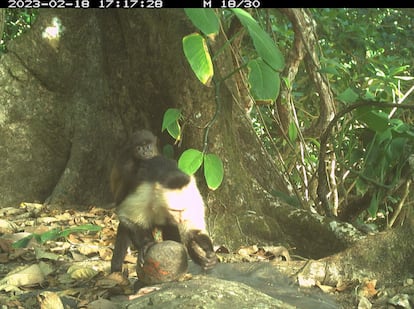Adolescent capuchins kidnap the offspring of howler monkeys out of boredom
The behavior, which ends with the death of the young, was initiated by a young primate and imitated by others
A group of teenagers, a lot of free time, and little oversight from their elders. Great things can emerge from this scenario, but it’s also the ingredients for a series of tragic events in paradise. On Jicarón Island (Panama), within Coiba National Park, a dozen babies were torn from their mothers’ hands, dying days later amid the neglect and curiosity of their captors. The behavior observed among a group of white-faced capuchins (Cebus capucinus imitator) is extraordinary: the kidnapped monkeys were babies of another species, Panamanian howler monkeys (Alouatta palliata coibensis). It would seem like teenaged mischief if it weren’t for the fact that all the kidnapped monkeys died within a few days. The authors of this discovery can only find one explanation for a behavior with no obvious benefits or biological meaning: something very similar to boredom.
Infanticide is not uncommon in the animal kingdom. But as harsh as it may seem to human eyes, it makes sense. Hyenas kill lions’ young, and lions kill the former’s young because they compete for the same resources and would one day grow up. Among chimpanzees, a female’s young can be killed by the dominant male if it interferes with his desire to mate. These behaviors are part of evolutionary logic. But what they discovered in Jicarón doesn’t fit. There are known cases of kidnapping, as happens among baboons, which do so as a means of reducing violence against the kidnapper, but kidnapping of young between species is incredibly rare.
“By chance, I stumbled upon a sighting in April [2022] of howler monkey pup number 2,” says Zoë Goldsborough, a researcher at the Max Planck Institute for Animal Behavior in Germany. For years, there has been a research center for the two monkey species on Jicarón. The island, 35 miles off the Pacific coast of Panama, has become a large natural experiment. Uninhabited, the topography doesn’t make things easy for scientists, so they had to deploy almost 100 cameras with motion sensors. In the video, a young capuchin they call Joker can be seen carrying the tiny howler, just a few weeks old, on his back. Goldsborough told her thesis supervisor about it, and, skeptical, they decided to review all the recordings from all the cameras since they began deploying in 2017. “When we investigated the data, we reconstructed the timeline and found the previous sightings,” he adds. It was then that they discovered when this new behavior emerged, on January 26 of that year. In the previous years, they found nothing. So they are convinced that it started then and it was Joker who initiated such behavior.
Looking back, they found no more adolescent capuchins carrying howler monkeys either in the following spring or summer. They thought it had been an isolated incident. But at the end of September, cameras again recorded a capuchin with a young howler monkey. And again in October, and in December, and in March of the following year... Up to July 2023, several of the capuchins in Joker’s group carried up to a dozen howler monkeys. But something had changed: Joker’s followers were now more aggressive and dismissive of the young. The researchers were baffled. Although they knew of occasional cases of adoption between the two species, the adopters had always been adult females, not a group of juveniles. They sought the opinion of a howler monkey expert, who confirmed that the young howler’s calls were for help. Their mothers can also be heard responding in the videos. But in every case where their offspring tried to escape, they were recaptured by the capuchins, who punished them with blows and bites. The researchers were witnessing kidnappings.

These young capuchin kidnappers belong to a group that became famous a few years ago. Although several continental species of robust capuchins (of the genus Sapajus) had been discovered using tools to obtain food, nothing like this had ever been seen among the smaller species (of the genus Cebus, such as those on Jicarón Island). But in 2018, a study was published showing how the island’s monkeys used large stones to break open the fruit of a tree called the tropical almond, hermit crabs, or seashells. For the authors of this study (published in Current Biology), both behaviors — kidnapping and tool use — could be related.
“We documented the first instance of stone tool use such as hammer and anvil in the genus Cebus,” recalls Brendan J. Barrett, also of the Max Planck Institute for Animal Behavior and Goldsborough’s thesis co-supervisor. The discovery marked the addition of this fourth group to the group of primates with the cognition necessary for these behaviors. These already included the great apes (including humans), macaques, and the robust capuchins of South America, from which the first diverged about six million years ago. “Studying how these capuchins compare with mainland ones can give us great insights into how island ecology affects social behavior, cultural transmission, and adaptation to challenging ecosystems,” he adds.
Regarding the behavior of Joker and his group mates, they only have a few possible explanations. “There is no evidence that kidnapping howler monkey pups provides any benefit to these capuchins,” Barret points out. “However, they likely have a lot of free time and, potentially, a lack of stimulation, due to the unique ecological conditions presented by the islands.” They have no predators, so they don’t need to stay together for safety and, consequently, interact less with each other. This has led to reduced social control within each group. For this researcher, “if you place a highly exploratory, social, and stimulus-seeking animal in a safe and unexciting environment, it might seek out opportunities to satisfy its innovative drive out of boredom.” This could explain their success with tools, but also the emergence of social behaviors that make no biological sense, such as kidnapping.
Meg Crofoot, director of the Department of Animal Ecology at the Max Planck Institute for Animal Behavior and co-supervisor of the discoverer’s thesis, doesn’t speak so much of boredom as a cause, but rather as a precondition for the emergence of divergent behaviors. “Our hypothesis is that boredom contributes significantly to the conditions that allowed this tradition to emerge... However, we don’t think capuchins kidnap howler monkey infants out of boredom; we didn’t observe them playing with the infants or interacting much with them,” Crofoot, senior author of this research, said in an email. For her, once the innovator, Joker, initiated this behavior, “other (younger) males seem to have copied it, perpetuating the trend not because it benefits them, but perhaps simply because everyone else is doing it.”
Crofoot has many doubts about the moral characterization of these behaviors. Watching the videos posted on a special website to showcase their discovery is very disturbing and unsettling. Capuchins don’t mistreat the howler monkey babies, except when they try to escape. But they don’t play with them either. They simply carry them around, and when they tire, they ignore them. All were infants, and although they only filmed the deaths of four, they are convinced that all of them died.
“If the evil considered in the banality of evil [a phrase coined by philosopher Hannah Arendt about Nazi extermination] is not so much the action itself, but rather the inability to think about and evaluate one’s own behaviors (which is how I interpret Arendt), then we are still in the early stages of understanding the extent (if any) to which nonhuman animals possess this capacity,” Crofoot cautions. “While we know that some animal species (including capuchins) behave in ways consistent with having a theory of mind (the ability to attribute mental states like desires and beliefs to others), we don’t know whether these capacities extend to concepts like the desire to avoid suffering. Furthermore, to my knowledge, no study has shown that such understanding generalizes to members of another species.” The anthropologist, a prominent researcher of primate behavior, concludes: “So, if capuchins’ cognition and reasoning don’t incorporate this kind of self-reflection, can their actions be understood as evil? I would say no.”
Sign up for our weekly newsletter to get more English-language news coverage from EL PAÍS USA Edition
Tu suscripción se está usando en otro dispositivo
¿Quieres añadir otro usuario a tu suscripción?
Si continúas leyendo en este dispositivo, no se podrá leer en el otro.
FlechaTu suscripción se está usando en otro dispositivo y solo puedes acceder a EL PAÍS desde un dispositivo a la vez.
Si quieres compartir tu cuenta, cambia tu suscripción a la modalidad Premium, así podrás añadir otro usuario. Cada uno accederá con su propia cuenta de email, lo que os permitirá personalizar vuestra experiencia en EL PAÍS.
¿Tienes una suscripción de empresa? Accede aquí para contratar más cuentas.
En el caso de no saber quién está usando tu cuenta, te recomendamos cambiar tu contraseña aquí.
Si decides continuar compartiendo tu cuenta, este mensaje se mostrará en tu dispositivo y en el de la otra persona que está usando tu cuenta de forma indefinida, afectando a tu experiencia de lectura. Puedes consultar aquí los términos y condiciones de la suscripción digital.
More information
Archived In
Últimas noticias
Trump claims peace in Ukraine is near, but Moscow suggests otherwise
A survivor’s account of the Interoceanic Train accident: ‘We were scared because of the speed on the curve’
The Interoceanic Train, the Mexican alternative to the Panama Canal
What is known about the Interoceanic Train derailment in Oaxaca
Most viewed
- Oona Chaplin: ‘I told James Cameron that I was living in a treehouse and starting a permaculture project with a friend’
- Reinhard Genzel, Nobel laureate in physics: ‘One-minute videos will never give you the truth’
- Why the price of coffee has skyrocketed: from Brazilian plantations to specialty coffee houses
- Pablo Escobar’s hippos: A serious environmental problem, 40 years on
- Chevy Chase, the beloved comedian who was a monster off camera: ‘Not everyone hated him, just the people who’ve worked with him’










































